2023 Kawasaki Ninja ZX-4RR Review – First Ride
The state-of-the-art for lightweight sporting motorcycles
Some of us may remember back in the late '80s and early '90s when every major Japanese motorbike manufacturer produced high-quality 400cc sport bikes. They were direct copies of Superbikes of the time. The only problem was, we couldn’t get one here in the States. The closest we could get was Yamaha’s FZR 400, but it wasn't anywhere near the quality of build or styling as its gray market sibling, the FZR400RR SP. Kawasaki had its own mini Superbike in the form of a ZXR400.
2023 Kawasaki Ninja ZX-4RR
The new ZX-4RR is an excellent platform for both the beginner and well-experienced rider. With a starting price of $9,699.00, some may think it’s too much for a 400cc motorcycle. But where else are you going to find this much performance in an lightweight machine?
Editor Score: 86%
Engine | 18/20 | Suspension | 12/15 | Transmission | 7/10 |
Brakes | 9/10 | Instruments | 4/5 | Ergonomics | 9/10 |
Appearance | 9/10 | Desirability | 10/10 | Value | 8/10 |
Highs
- Great chassis and suspension
- Perfect size bike. Easy to ride. Doesn't wear you out.
- The ZX-4RR looks the business
Sighs
- Restricted engine
- Quickshifter down shift action needs some fine tuning
- Transmission is a little rough
Motorcycle.com would like to thank Motorcycle Mechanics Institute | MMI for sponsoring this First Ride.
Kawasaki unveiled the Ninja 250 in the US in 1986. Its most recent model, the Ninja 400 which appeared in 2018, is a fabulous little motorcycle. The current crop of entry-level contenders has steadily grown into an impressive group of affordable user-friendly motorbikes. Unfortunately, they are not afforded the same quality and coolness as the 400s of days gone by. Could Kawasaki’s new Ninja ZX-4RR bring back the excitement of owning an entry-level race replica Superbike? Let’s find out.
A full day of riding at Thunderhill Raceway in Northern CA was organized by Kawasaki for the launch of the all-new 2023 Ninja ZX-4RR. The concept behind the latest Ninja ZX-4RR was to design a motorbike that is user-friendly for the beginner and technically advanced enough for the more serious riders and racers amongst us.
The new ZX-4RR features an aggressive style design similar to that found on Kawasaki’s current Ninja models. The new ram air intake features the same centrally located intake placement as the ZX-6R and ZX-10R. It looks great, especially with its Supersport-style, low fuel tank, and tight-fitting bodywork. Kawasaki informed us that the new ZX-4RR has a more forward-leaning riding position than their current Ninja 400. Perhaps I’m lucky, but at around 5’ 10’’ in height, I seemed to be the perfect fit for the little Ninja.
A Quick-Revving Four
Once we fired up the bikes, the Ninjas came alive with that familiar Kawasaki exhaust note we all associate with their Supersport models. The engineers put a lot of time into the development of this bike with an eye on maintaining a nice balance between outright performance and daily rider usability. A new high-revving motor with a strong low to midrange torque curve also features robust high-rpm power for the track. To achieve its goal, Kawasaki designed an all-new 399cc liquid-cooled in-line Four engine with a bore and stroke of 57.0 x 39.16 mm.
The new cylinder head design sports a narrow valve angle and a precision machined combustion chamber. The intake ports received some extra attention at both the valve seat and port’s incline angle through the head. This has resulted in a straighter and wider intake tract. New 21mm intake valves and 19mm exhaust valves work in conjunction with the new lightweight forged camshafts and triple-rate valve springs. Lightweight pistons with a molybdenum-coating feature a crown specially designed for a 12.3:1 compression ratio. This allows for the use of regular pump gas, without harming the engine. The lightweight connecting rods receive a carburizing treatment to improve durability along with their reduced weight. The addition of a lithe flywheel completes the package to facilitate a quick-revving, high-performance engine. The very tidy 4-2-1 exhaust starts off with 31.8mm head pipes with joint pipes linking the headers to help with emissions and sound regulations. The collector pipes feature triple catalyzers for emissions control, freeing up the silencer and making it easy to add a slip-on muffler.
After several laps, I started to get more familiar with the new ZX-4RR and all of its amenities. Kawasaki’s (KQS) dual-direction quick shifter is standard issue and worked great on upshifts, but on downshifts, the interval timing felt off to me. The ZX-4RR clutch has both an Assist & Slipper function. While on the gas, the Assist cam pulls the clutch hub and operating plate together to compress the clutch to reduce slippage. Off the throttle, the Slipper function reduces the back-torque sensation to the rear wheel. In other words, corner entry at speed is an effortless affair. The slipper action was very well sorted. I was banging down the gears without worrying about matching revs to rear wheel speed.
The new Ninja receives the latest ETV (Electronic Throttle Valve) 34mm throttle bodies. With no noticeable dead spots or lag time, the throttle response is very friendly. Modulating the throttle mid-corner can sometimes upset a bike, but not the Ninja. It is a smooth and predictable affair. The tachometer goes to 16,000 rpm, but I only managed to get it to just over 15,000 before the rev limiter shut me down. At around 14,000 rpm the power seems to drop off.
Kawasaki claims the ZX-4RR makes somewhere close to 79hp with the Ram Air force feeding the atmosphere to the airbox at speed. (This information has been verified by ZX-4RR owners who have had their ECU flashed to eliminate the restriction.) Here in the US, due to emissions and noise standards, one is only left with around 56hp. Perhaps that's why it felt a little flat up top and wouldn’t reach the 16,000 rpm threshold. Nevertheless, the performance of the ZX-4RR is very respectable. The most important thing is to be able to control the bike with the throttle, however powerful it is. The ZX-4RR is very good in these terms with a precise connection from the throttle to the engine’s power delivery at the rear wheel.
Competent Chassis
For the chassis, Kawasaki engineers incorporated the same design parameters as their race-winning ZX-10RR. By doing so, they came up with the right combination of rigidity, balance, and weight distribution. It’s not the sophisticated box section aluminum frame we all hoped for, but the high-tensile steel trellis frame, featuring varying pipe thicknesses and a box section-like swingarm pivot area, seems to work pretty well. Add to that a long arch-style swingarm, also made of high-tensile steel, and you have all the makings for a true Supersport contender. It only weighs in at 414 lbs ready-to-ride, which is very respectable considering all the equipment that comes on street bikes nowadays. Still, we’re going to gripe a bit since this is only 14 lb. less than the non-ABS ZX-6R.
Suspension-wise, Kawasaki pulled out almost all the stops. The ZX-4RR comes with 37mm inverted Showa SFF-BP (Separate Function Forks-Big Piston) forks. The use of a large-diameter piston reduces damping pressure by allowing oil inside the fork to move on a much larger surface area. Although for some reason, there are no compression or rebound damping adjusters. Maybe it's a cost issue. At least there is a spring preload adjuster on the right fork leg. Showa’s BFRC lite (Balance Free Rear Cushion) shock is very similar to the one on the ZX-10R. The shock utilizes the same horizontal back-link mounting design, also featured on the ZX-10R. The new Showa rear shock is fully adjustable with compression and rebound adjusters, and the spring preload is also adjustable.
Thunderhill’s race course has a good selection of varying corners and altitude changes to challenge a motorcycle’s capabilities. The new ZX-4RR is very well suited to negotiate all the track has to offer. Turn two is a long lefthand corner that begs you to keep the power on while leaning over for several seconds. The ZX-4RR stayed in line, never running wide or squatting down in the rear while applying as much throttle as I felt comfortable with. Cresting the infamous turn five at T-Hill then dropping down into turn six loads the suspension in two different ways. The weight transfers to the rear going up the hill into turn five, causing the ZX-4RR to pack down some. It held its attitude nicely, allowing me to brake hard then set up the corner and throw it on its side. Exiting down the hill into turn six, the bike loads the front. This could be a problem, however the Ninja stayed composed, never overloading the front end.
By mid-day, I was pretty much going flat-out through the very fast kink in turn nine. If the ZX-4RR was going to falter, it would be here. The whole bike loads up in the dip at the apex, luckily the Ninja barely moved around. I even dragged the pegs a few times. I had it wound up in several other corners, but each time, the ZX-4RR performed like a well-sorted Supersport should. If you override the little Ninja, you can get it to protest more than you may like. But it always returns to its sweet spot, providing a stable and predictable connection to the road.
The ZX-4RR turns on a dime, but if you get in too hot (I did a few times) or have to change your line mid-corner, the Ninja will cooperate with any adjustments you need to make. It finishes the corners with minimum effort, you won't have to fight it, just pick your line and go. The front forks soaked up almost every obstacle without fault with a surprising amount of good damping force. The rear is equally as impressive. The shock provides plenty of control while accelerating or cornering. The one thing I did come to notice was the rear end seemed to pack down a bit mid-corner and on the exits. I decided to take a half-turn of rebound damping out of the rear shock which remedied the issue. Unlike some of the other entry-level lightweight competitors, the ZX-4RR never got out of shape at speed. The chassis stayed composed even under the most extreme of race track flogging. Believe me, we were all pushing the Ninja to its limit without fail.
On the Brakes
For the brakes, Kawasaki chose dual 290mm semi-floating front rotors with monobloc Nissin calipers handling the stopping power. The calipers have two different piston sizes: 32mm for the upper pistons and 30mm for the lower ones. The feel at the lever allows you to modulate the amount of braking force required, giving you the confidence to brake hard or tail-brake into corners with a good sense of control. The ZX-4RR KRT edition comes with ABS which features Nissin’s new ABS control unit. Overall, the ABS intervention was barely noticeable except in a few hard-braking situations.
Kawasaki graced the new ZX-4RR with an electronics package similar to its ZX-6R and ZX-10R siblings. Kawasaki Traction Control (KTRC), power modes, riding modes, and the Kawasaki Quickshifter (KQS) are all standard on the ZX-4RR. The (KTRC) Traction Control has three levels of intervention to choose from. Mode 1 is the least intrusive while Modes 2 and 3 are more intrusive, respectively. You can also choose to turn the system off. There are two Power mode levels, Full Power/Low Power, indicated on the display by either an “F” or an “L”. The Ninja has three pre-set Ride Mode settings: Sport, Road, or Rain. These modes are designed to facilitate a quick and easy rider control choice. However, if you want to customize any of the 3 pre-set modes, a fouth manual Ride mode allows you to set up your own personal riding experience. Circuit mode is dedicated for track use and changes the dash display by showing your lap time in the center of the screen in large text.
The system is easy to navigate via a two-way switch on the left side handlebar cluster and a selector button on the throttle side cluster. All the info is displayed on a new 4.3-in. digital TFT dash. The new dash features a digital speedo, bar-style tach, and gear selection display. Of course, the usual features like mileage, running temperature, fuel gauge, clock, remaining range, battery voltage, smartphone calls, and email notices are also present on the dash. I didn’t realize at first, but once you reach 10,000 rpm the gear position and tachometer display will become more visible along the top of the screen. The TFT screen display can be personalized with various selectable backgrounds and text color choices. The dash also features Bluetooth technology so you can connect to the bike wirelessly through Kawasaki’s Rideology App. When using the Rideology App, you can retrieve information about all the functions of the motorcycle, riding data, and history on a smartphone.
For the fourth session, I turned off the KTRC, set the power to full, and went at it. The Ninja seemed to be a little rougher around the edges at full tilt. The bike felt more aggressive coming out of the corners. You have to be aware that although the OEM Dunlop Sportmax GPR-300 tires (120/70ZR-17” front and 160/60ZR-17” rear) are good tires, at race track speed they are not quite up to the task. This is where the KTRC was a useful accessory. Without the TC active, the Ninja seemed to move about more mid-corner and on the exits. Fortunately, the chassis provides good feedback, so you can feel what’s going on and initiate corrective measures to avoid binning it. I switched back to the standard Sport Mode setting for the next session and surely enough, the ZX-4RR smoothed right out. The pre-set Sport mode made the Ninja easier to ride, but it took some of the fun out of it. I tried the Rain modes option which is very intrusive – almost to the point of not being able to get around the track. But for beginners and/or those riding in the rain, it should be a great option. The Road option was more suited to everyday riding. It provides decent power and the TC intervention is far less noticeable.
The Checkered Flag
The new ZX-4RR is an excellent platform for both the beginner and well-experienced rider. With a starting price of $9,699.00, some may think it’s too much for a 400cc motorcycle. But where else are you going to find this much performance in a lightweight machine? Spend a little more and get a whole lot more. Kawasaki’s new 2023 Ninja ZX-4RR is impressive. You will be hard-pressed to find a flaw, no matter how hard you try. The latest little Ninja is ready to command some serious attention both on and off the track.
In Gear

- Helmet: Arai Corsair X Rea 6 Green
- Leathers: Alpinestars GP Plus V4 1PC Leathers
- Airbag: Alpinestars Tech-Air 5 System
- Gloves: Alpinestars GP Tech V2 Gloves
- Boots: Alpinestars Supertech R Vented Boots
2023 Kawasaki Ninja ZX-4RR KRT Specifications | |
|---|---|
MSRP | $9,699 |
Engine Type | 4-Stroke, Liquid-Cooled, DOHC, 4 Valves Per Cylinder, Inline 4 |
Displacement | 399 cc |
Bore and Stroke | 57.0 x 39.1 mm |
Compression ratio | 12.6:1 |
Horsepower (claimed) | 56 hp |
Torque | 26.5 lb-ft. at 11,000 rpm (Claimed) |
Fuel system | DFI w/34mm Throttle Bodies(4) |
Ignition | TCBI with Digital Advance |
Transmission | 6-speed KQS with Positive Neutral Finder |
Final drive | Sealed Chain |
Clutch | Wet multi-disc, Slip/Assist |
Frame | Steel Trellis |
Front Suspension | ø37 mm Inverted SFF-BP Fork with Adjustable Preload and Top-out Springs |
Rear Suspension | Horizontal Back-link with BFRC lite Shock with Piggyback Reservoir, Adjustable Preload, Compression, and Rebound Damping, Top-out Springs |
Front Tire | 120/70-17 |
Rear Tire | 160/60-17 |
Front Brake | Dual Semi-floating 290 mm Discs with Radial-mount, Monobloc Opposed 4-Piston Calipers |
Rear Brake | Single 220 mm Disc with Single-Piston Caliper |
Caster (rake) | 23.5° |
Trail | 3.8 inches |
Overall length | 78.4 inches |
Overall width | 30.1 inches |
Overall height | 43.7 inches |
Wheelbase | 54.3 inches |
Seat height | 31.5 inches |
Curb Weight | 414.5 pounds (Claimed) |
Fuel capacity | 3.96 gallons |
Warranty | 12 months |
Kawasaki Protection Plus | 12, 24, 36, or 48 months |
We are committed to finding, researching, and recommending the best products. We earn commissions from purchases you make using the retail links in our product reviews. Learn more about how this works.
Become a Motorcycle.com insider. Get the latest motorcycle news first by subscribing to our newsletter here.
More by Tom Montano






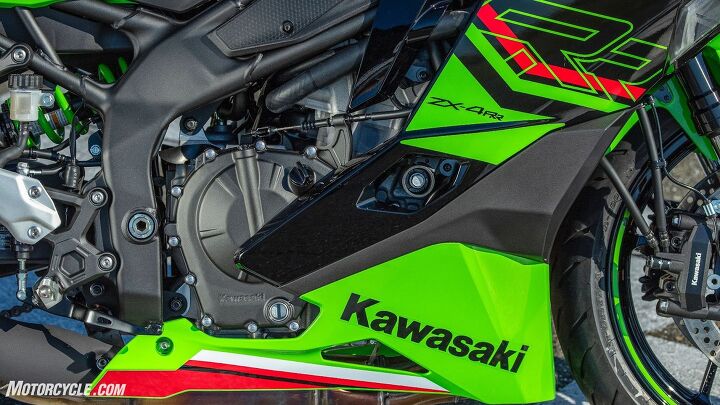


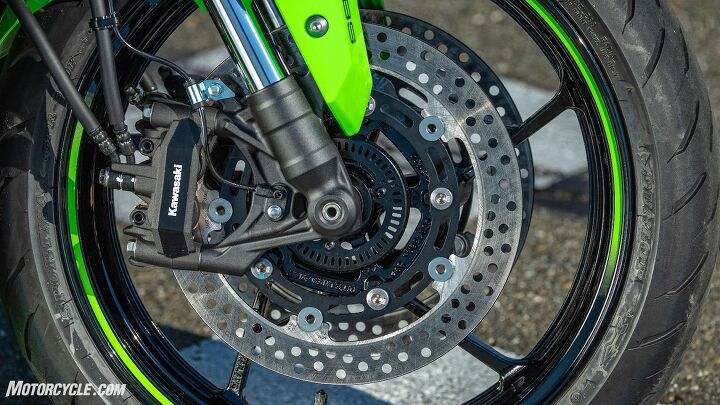





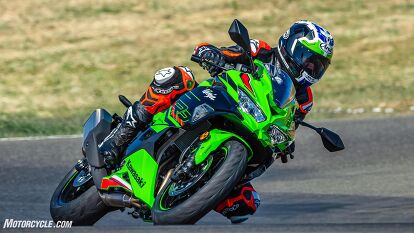



































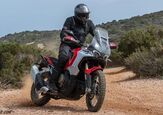

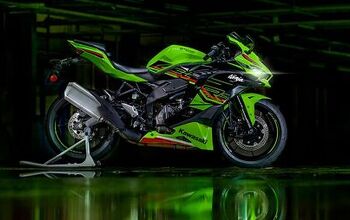

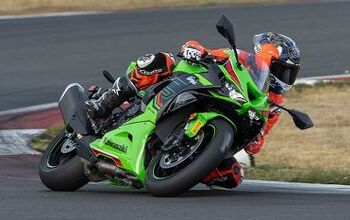














Comments
Join the conversation
.32 hp/kg at 56 hp and if you stoke it up to 80 hp you get .45 hp/kg 414.5 lb to 174.5 kg assumed with 30 lbs of fluids removed for a dry weight. At $9,700 I just do not see the "light weight" aspect, unless you are referring to the negative mass of my wallet after purchase. Maybe this works across the pond but that is a different place from the USA entirely. Nice bike and review though.
ECU reflash will release the pent up HP. Probably won't cost that much. OK that's doable.
But 414 wet, steel frame, and preload only forks, $10k 400?!
No.